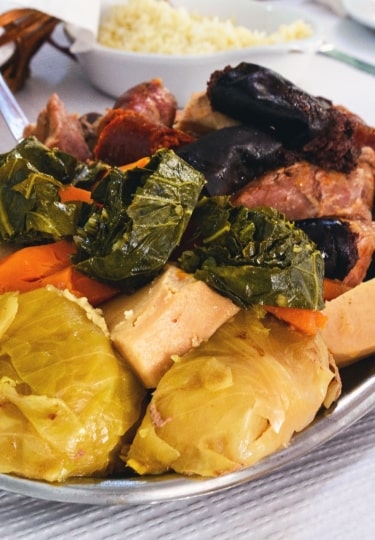Thanks to its isolated location in the middle of the Atlantic Ocean, Azores food focuses heavily on seafood. But the menu on these volcanic Portuguese islands extends far beyond fish.
Influenced by mainland Portugal’s traditional dishes, the bounty of the sea, verdant-yet-volcanic soils, and a unique climate that allows tropical fruits and even coffee to flourish, Azorean gastronomy is an adventure for the taste buds.
From volcanic-steam-cooked stews to fresh from-the-plant pineapples, here are some of the best dishes to try on your next trip to the Azores.
Lapas dos Açores

Lapas dos Açores
One of the most popular and typical shellfish dishes you’ll find across the Azores are lapas, a mollusk similar to clams, also known as limpets.
Similar in flavor to mussels but slightly chewier, lapas appear everywhere, from highbrow restaurants to cafés and tascas. They’re most commonly eaten as a petisco (small plate) appetizer or a light lunch.
Found in abundance on the coastal rocks around the islands, they are prized off with a sharp tool and should be eaten as soon as possible after harvesting.

Lapas dos Açores
Usually, the limpets are prepared in a griddle pan, cooked simply in a sauce of butter, garlic, and lemon juice. Served at the table in the still sizzling pan, it’s quite a spectacle. In some restaurants, lapas are served raw, like oysters, so check the menu before ordering.
Bolos Lêvedos das Furnas

Bolos Lêvedos das Furnas
Perfect for dipping in garlic sauce, or served with garlic butter, the Bolo Lêvedo bread is another of the most typical Azores foods. It’s also a common replacement for burger buns and sandwich bread and makes a great to-go snack with garlic butter, cheese, and ham.
Part bread, part cake (due to baking with a little sugar), the shape is similar to a muffin, and the original recipe hails from São Miguel island’s first settlers. You may already be familiar with these muffins if you’ve visited New England, thanks to the large Portuguese immigrant population there.
The most famous Bolo Lêvedos are baked in Furnas, a volcanic hot-spring town on the largest island, although you’ll see them on nearly every menu in the archipelago.
São Jorge Cheese

São Jorge cheese
Cheese on the Azores is celebrated for its supreme flavors, often credited to the verdant landscapes and free-roaming, caramel-spotted cows. The most famous Queijo on the archipelago hails from São Jorge Island and is usually served as an appetizer in restaurants.
Semi-hard and made from unpasteurized cow’s milk, the golden-hued wheels are delicious. While the smaller wheels are tasty, the larger ones cut into wedges usually have more flavor.
The cheese is matured for a minimum of 90 days, and the longer the aging process, the more prized this DOP (Protected Designation of Origin) cheese becomes. It’s mild, but the buttery taste with a pinch of spice makes it one of Portugal’s most renowned.
Other dairy products are just as delicious, and the Quinta dos Açores ice-cream pots, with various locally-inspired flavors, make for a great sweet treat.
Chicharros Com Cebolada
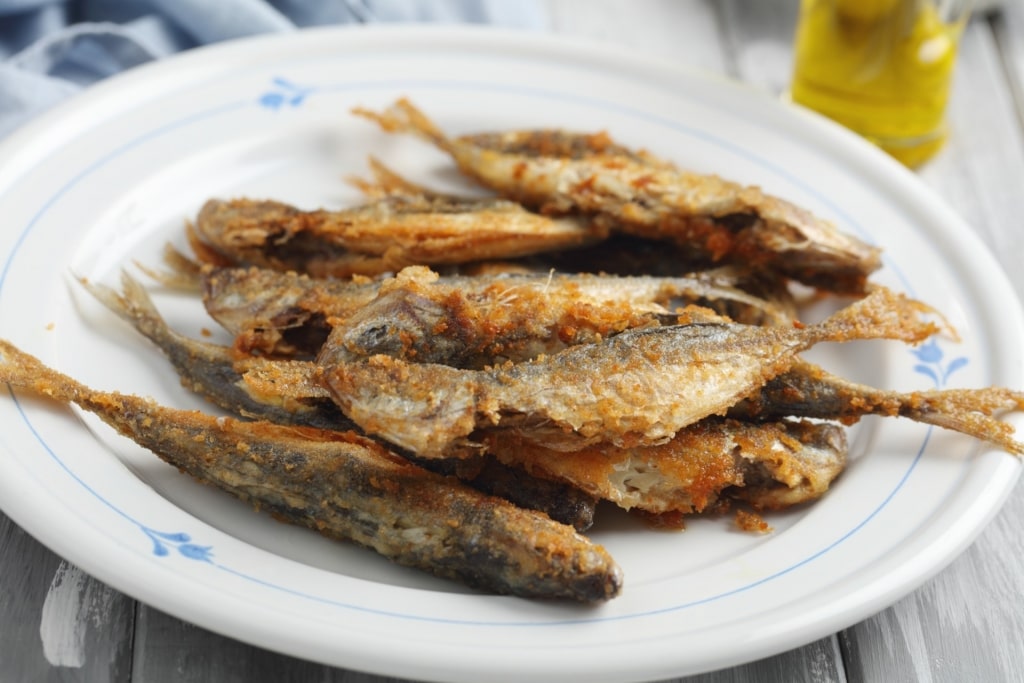
Chicharros
One of the most simple recipes and popular tapas-style dishes are chicharros (Atlantic horse mackerel), which are fried in oil and then mixed with a tomato and onion sauce.
Once regarded as a poor man’s food due to the high quantities and affordable prices, mackerel has recently been making a resurgence, and you’ll find a few more creative takes on this traditional dish in the restaurants of Ponta Delgada.
Cozido das Furnas
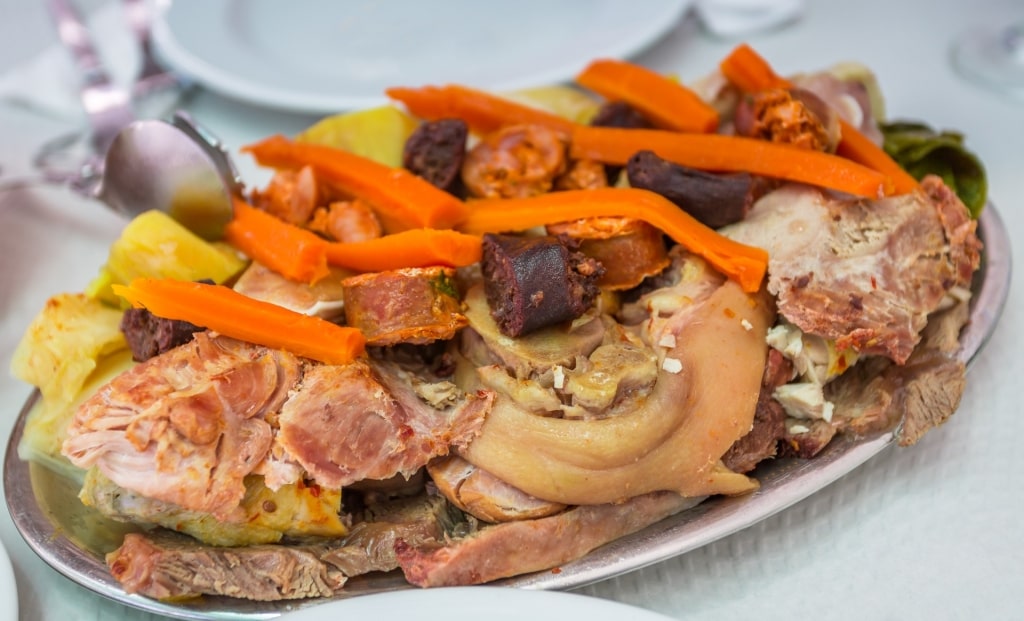
Cozido das Furnas
For a unique experience and to taste one of the most characteristic Azores foods, head to Furnas on São Miguel Island. This inland town is renowned for its volcanic activity, thermal springs, geysers, and naturally-heated spa pools.
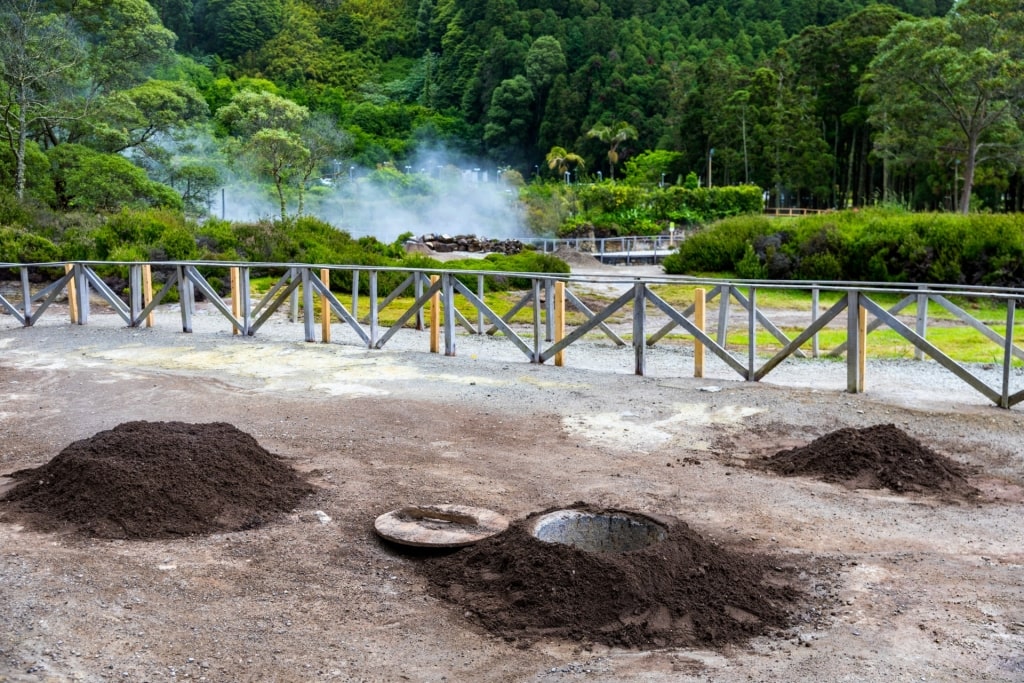
Furnas
The town’s residents also harness the natural heat to cook, and this one-pan, meat-heavy dish is the result. Once the beef, pork, bacon, chicken, potatoes, cabbage, and other vegetables have been seasoned and combined, they are lowered into a pit and buried.
These underground ovens are located next to natural boilers, and over the next five to seven (or sometimes longer) hours, everything is slowly cooked to create a unique taste.
Once ready, it’s mounded high on a plate and served to the table. Non meat-eaters can ask for corn on the cob prepared inside the underground steam ovens.
Azores Wine
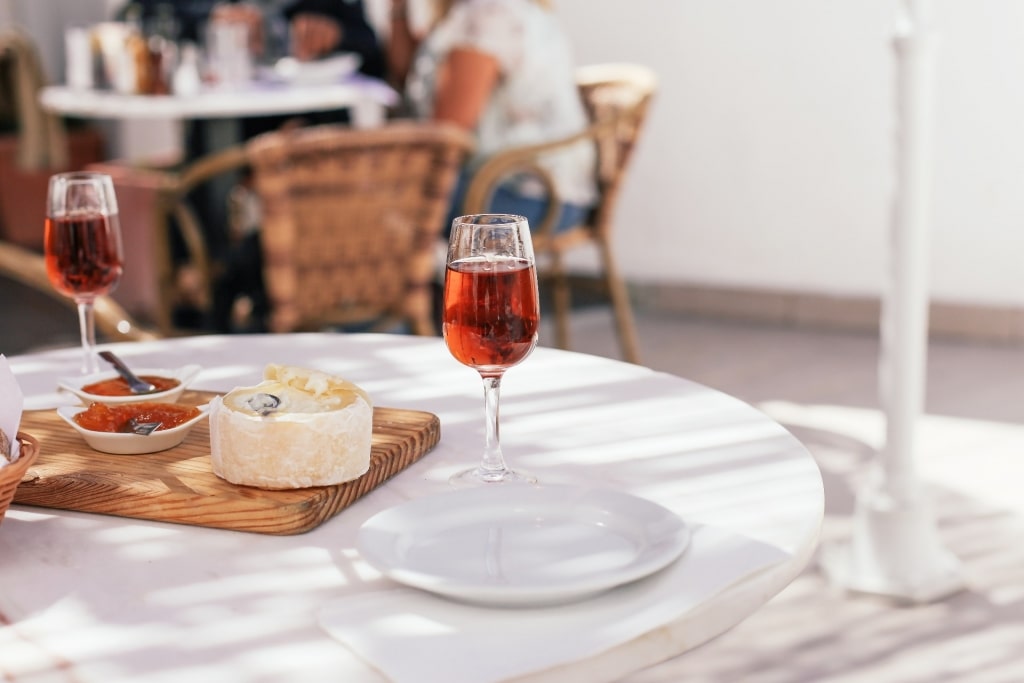
Azores wine
Portugal is famous for its wine, and the wines of the Azores are exceptional in more ways than one. Cultivating vines in rocky, volcanic soil may sound impossible, but on the island of Pico, not only have they done so, but it’s also earned UNESCO-protected status.
To protect the wines from the Atlantic winds and to help them flourish in the black volcanic terrain, the tedious and painful task of creating currais, small rectangular plots, began hundreds of years ago.
Hacking out the stone from the ground allowed the vines to be planted, with the removed stone used to form the protective walls.
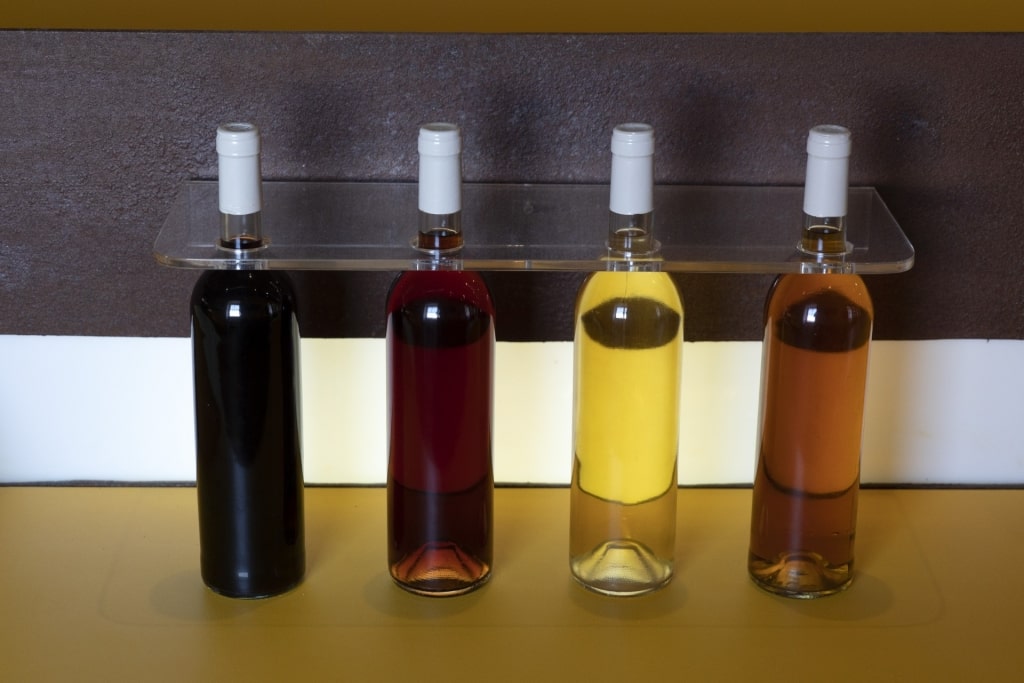
Azores wine
For wine tastings, you don’t need to venture to remote Pico. Many of São Miguel’s bars stock at least a few of the local wines. Bottles of mainly whites and rosés are most interesting; the whites are often slightly golden in color, with hints of tropical fruits as well as an indescribable “volcanic” taste that’s unique.
Perhaps slightly better known are the fortified wines made from Verdelho. This grape is also used in the more famous Madeira wine, the Azores’ sister archipelago, and makes for an excellent digestif.
Gorreana Tea
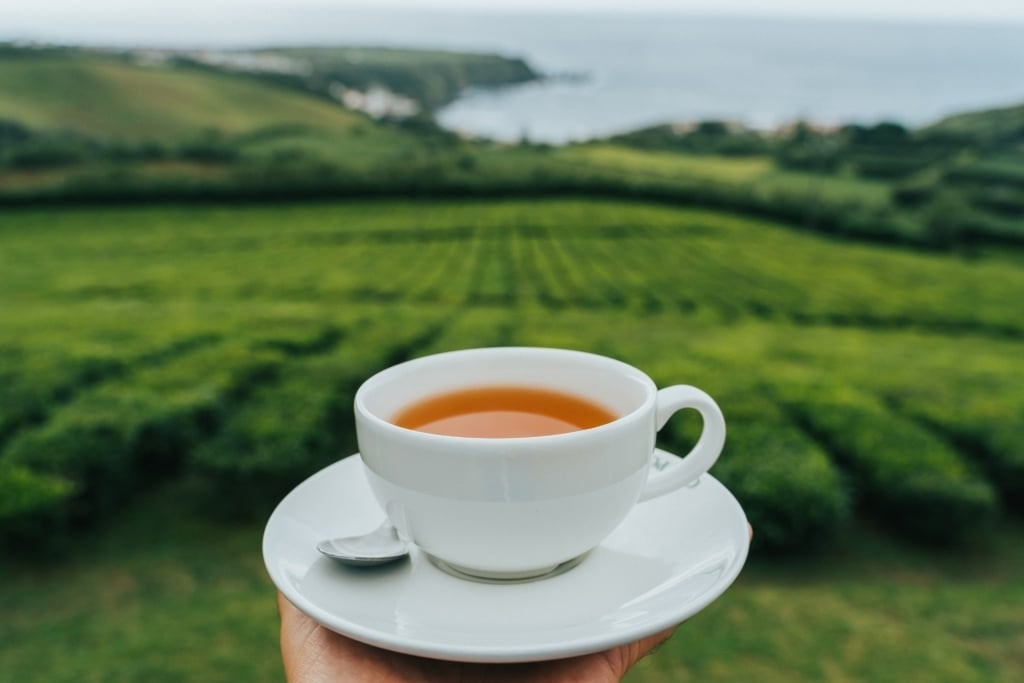
Gorreana tea
One of the prettiest spots on São Miguel Island, the Gorreana Tea plantations are another unique sight. Since 1883, they have been producing fine black and green teas, making this the oldest tea grower in Europe.
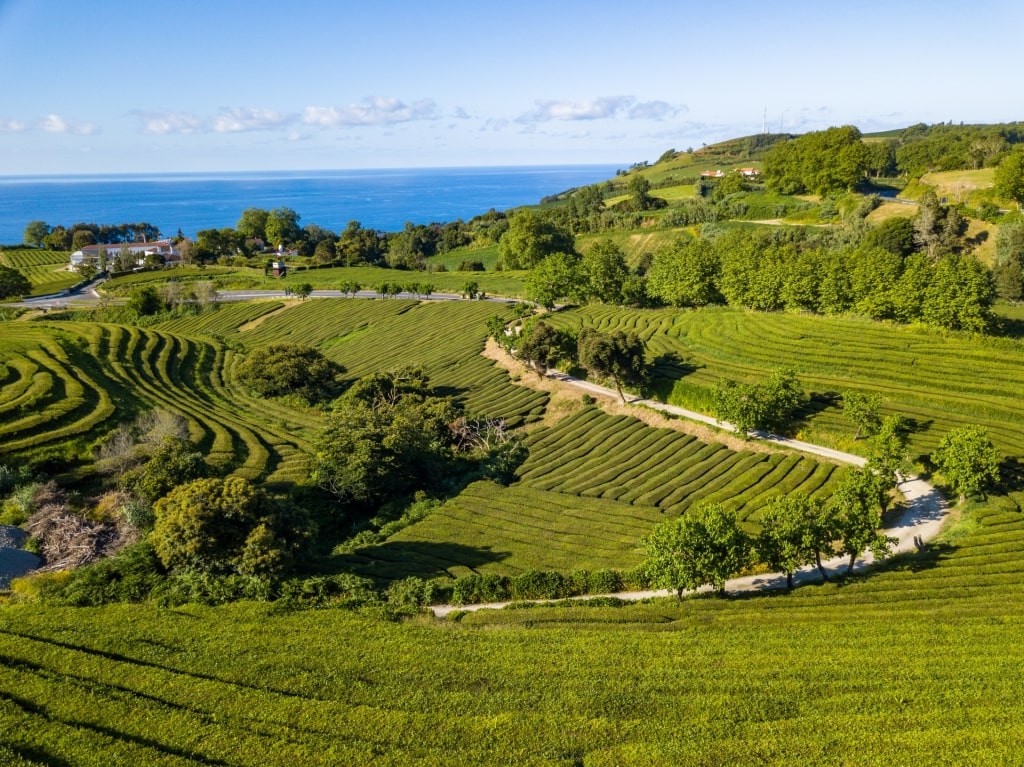
Tea plantation in the Azores
You can walk freely through the tea plantation, which cascades down the hills, providing mesmerizing panoramas of the verdant rows of plants against the cerulean ocean.
Afterward, a factory tour briefly shows you this family-run business’s production and packaging facilities, followed by tasting the local infusions in the small café.
If you can’t make it to the plantation, most cafes in Ponta Delgada proudly serve their island’s own leaves.
Read: Most Beautiful Places in Portugal
Alcatra
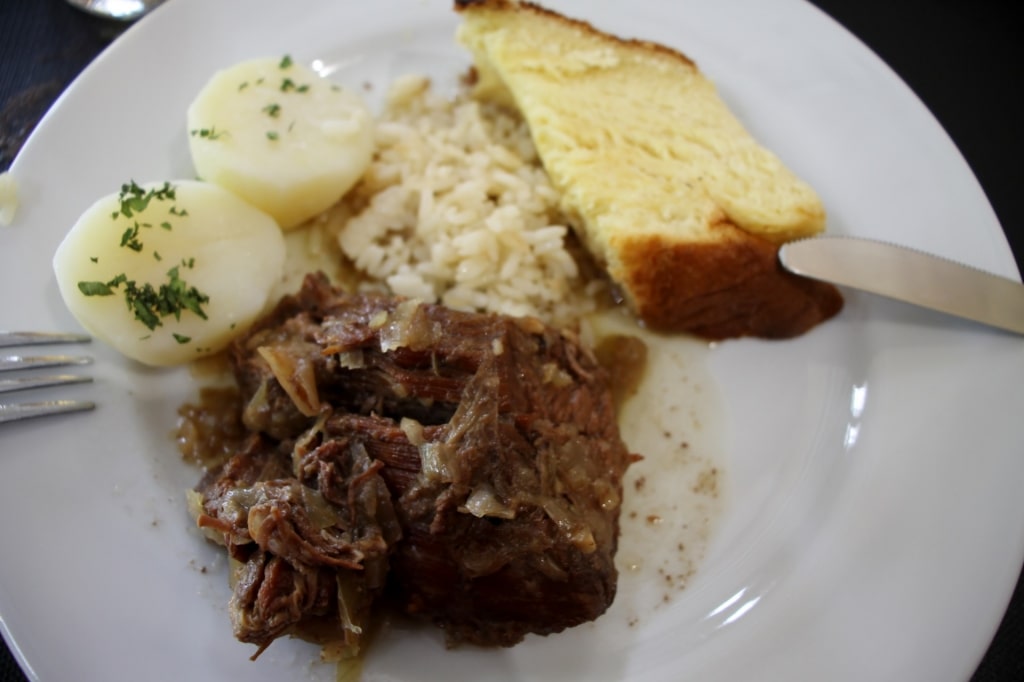
Alcatra
Hailing from Terceira Island but found on some menus across the nine islands, this traditional roast beef dish makes for a hearty meal.
Prepared in a clay bowl using one of the best available cuts of beef, the meat is diced into chunks. Then, it’s slowly roasted, a process that is key to the thick sauce of onions, wine, garlic, bay leaves, and bacon in which the tender meat swims.
Ananás dos Açores

Ananás dos açores
Another surprise food in the Azores, especially from a European island, is ananás, a locally harvested pineapple.
These greenhouse-grown pineapples are a peculiar sight in Europe and aren’t just a novelty; they’re also award-winning, thanks to their sweet flavor and small size.
Just outside Ponta Delgada, you can walk through the farm, peeping inside climate-controlled rooms and learning about the history of the Azorean tropical fruit.
In the open-air café, you can try some slices (delicious sprinkled with a little salt) alongside various other pineapple products, including jams, and even a tempting liquor.
Cavaco (Locust Lobster)
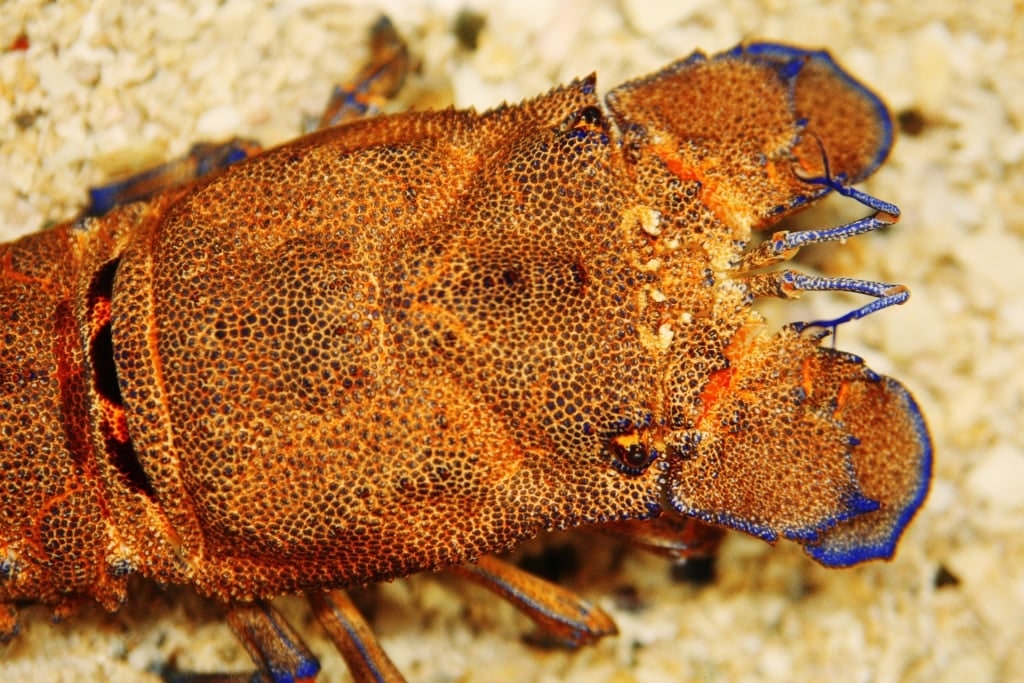
Cavaco
Seafood is always plentiful in the Azores, and for a fine meal, try the peculiar-looking local locust lobster, cavaco.
Found inside the canyons and rock caves around the islands, these crustaceans are caught seasonally and are pretty easy to find during summer. With tender meat, cavaco are best enjoyed grilled with a squeeze of fresh lemon and, ideally, an ocean view.
Tuna
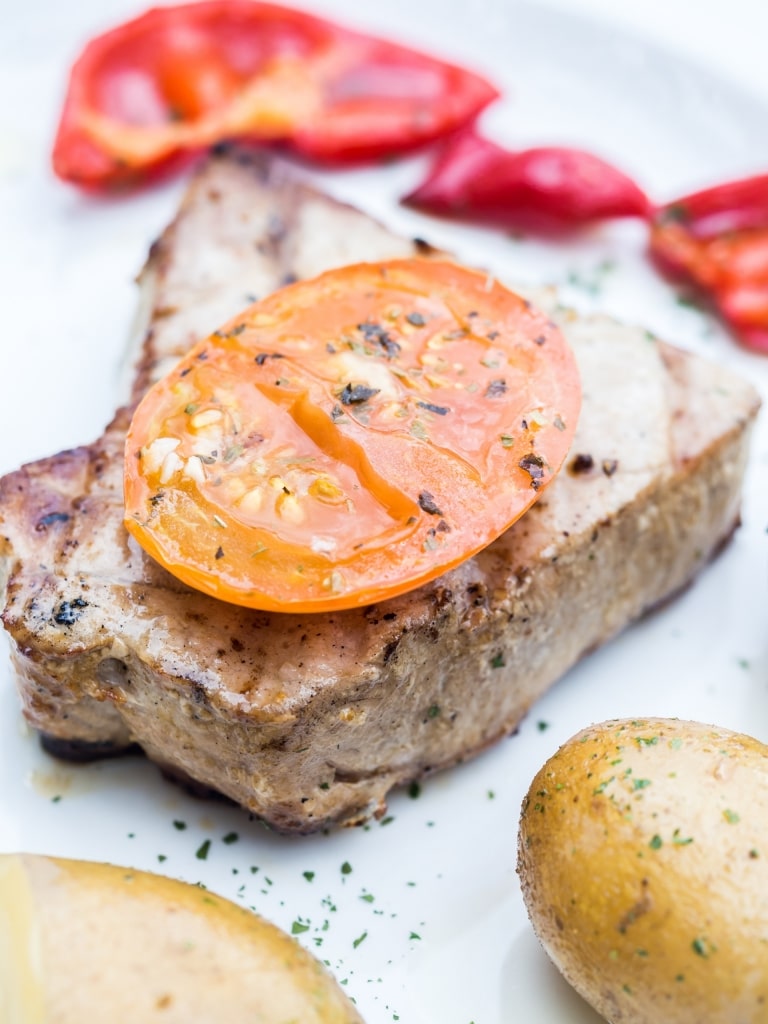
Tuna
Another excellent and popular fish in the Azores is tuna, usually served as a large, juicy steak.
The various species found in the surrounding waters, including bluefin and yellowfin, are of such high quality that they are often offered seared, but rare inside, so be sure to clarify your preferred cooking method. In fact, they are so lauded, Azores’ tunas are even exported as far as Tokyo.
If you pass by Ponta Delgada’s Mercado da Graça, you might spot one of these giant fish whole, quite the sight to behold.
Seafood
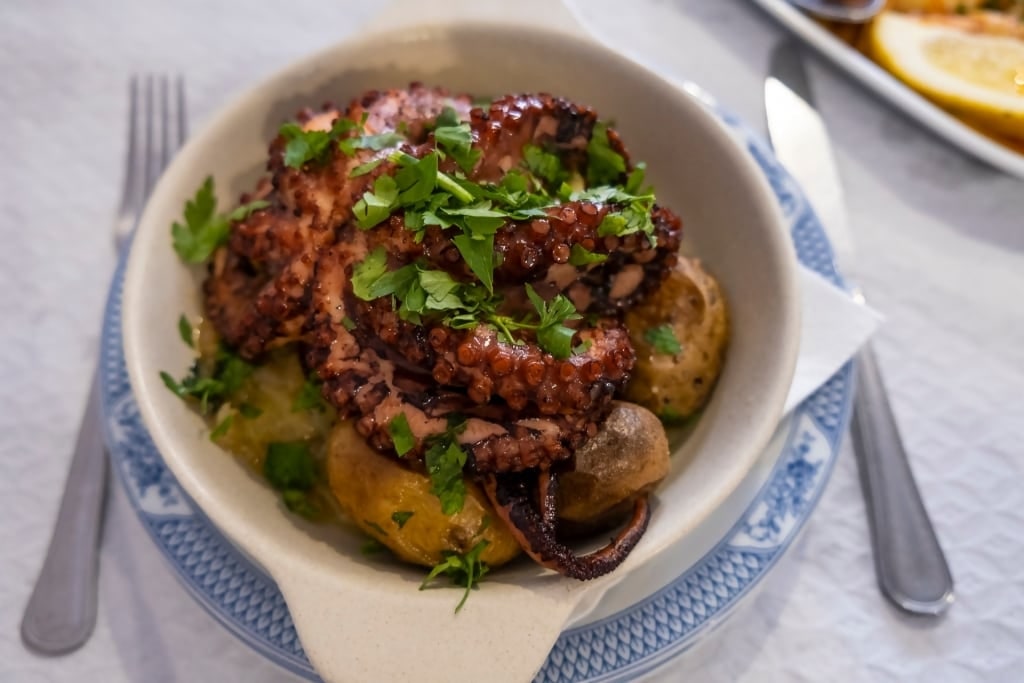
Octopus stew
As an archipelago of nine islands far from the mainland, the Azores produces an array of other seafood that’s readily available and freshly caught.
Octopus stew is a typical Azores food that hails from Pico island, while clams, squids, and swordfish are also on the menu.
A few less commonly known species also feature, such as cherne (wreckfish) and alfonsino, a type of red bream. Usually, the whole fish is grilled and served whole, with a squeeze of lemon and a little seasoning.
Azorean Coffee
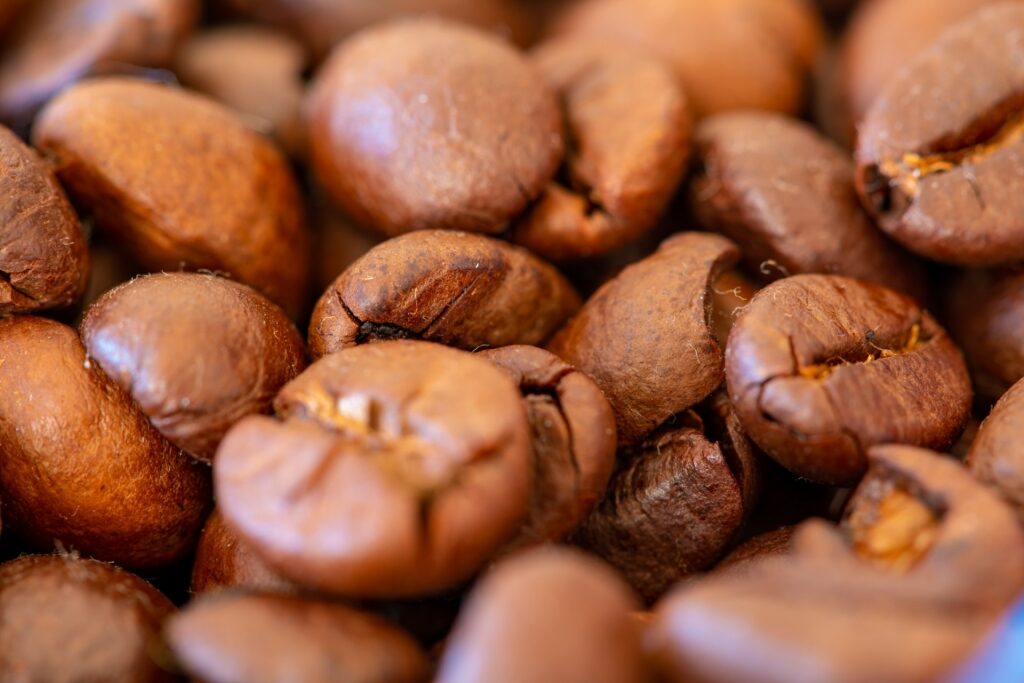
Azorean coffee beans
Many visitors to the Azores are surprised to learn that alongside the tea plantations, there is also a coffee farm.
Situated on rugged São Jorge, on a plateau spilling out to the sea, it’s not the easiest place to visit. The coffee plants likely arrived from Brazil in the 18th century and now provide a unique contrast to the surrounding volcanic terrain.
For those who can’t make the journey to São Jorge, regional produce stores in the capital sell small bags of Arabica to take home.
Morcela
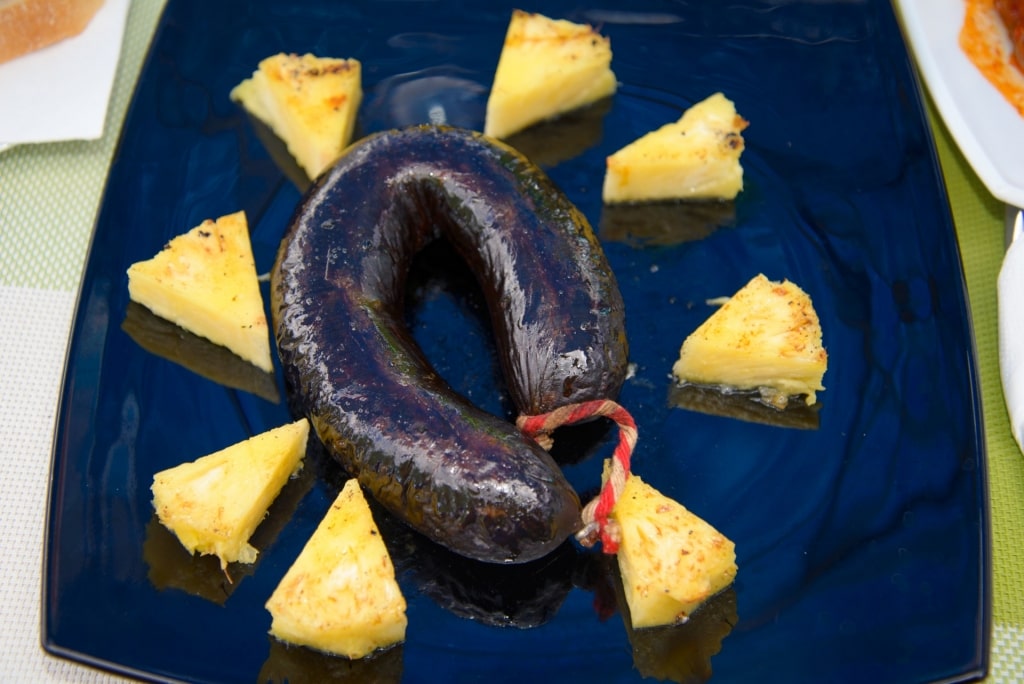
Morcela
This black pudding sausage is a specialty both in Portugal and the Azores, with a tropical twist on the island’s plates.
It’s usually served fried with slices of pineapple, and the combination of salty and sweet makes for an excellent appetizer. While blood might sound unappealing to some, it adds a rich flavor to the otherwise pig meat sausages and is seasoned with pepper, spices, and garlic.
In a country where no part of the animal is ever wasted, it’s a common sight and is also often included in a rice stew dish, arroz de morcela.
If you’d prefer your sausages without the additional flavor, order Alheira, a more typical smoked sausage seasoned with garlic.
Massa Sovada
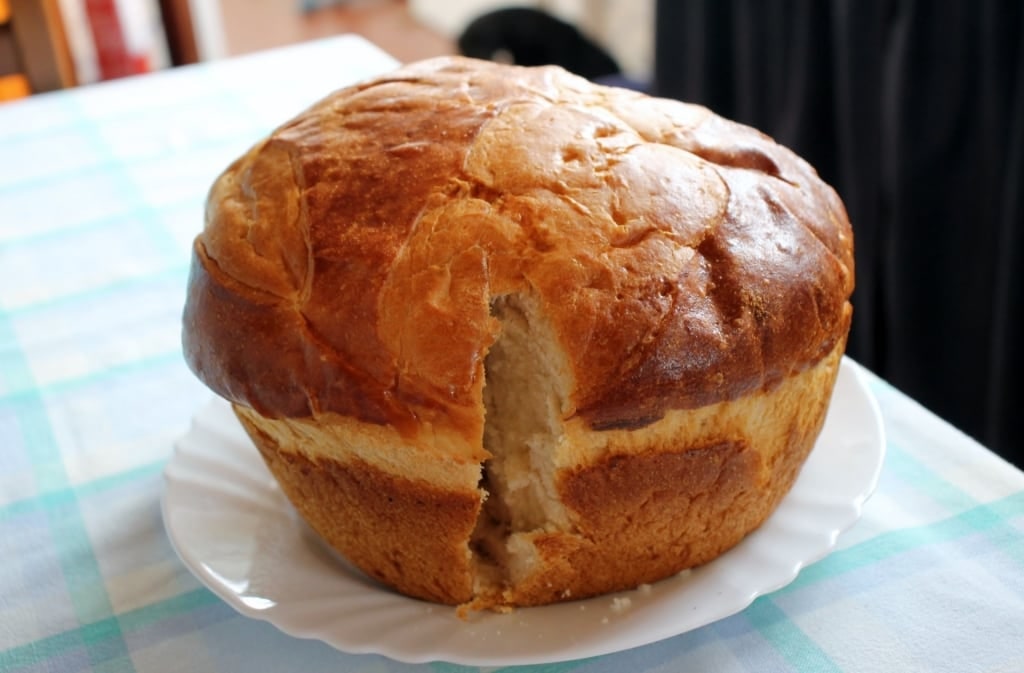
Massa sovada
This sweet potato bread is a traditional Azores food, often eaten during festivities and celebrations. The name literally translates to kneaded bread, and the kneading is essential to consistency.
After being left to rest overnight, the yeast and sweet potato puree are combined with the remaining ingredients before being left to rest again. A lot of time and love goes into this cake-like bread, so it’s a little harder to find than bolo lêvedo, though it can sometimes arrive as a side with soup.
Queijadas da Vila

Queijadas da vila
Queijadas, small, sweet, cheese-based pasties, are popular across Portugal, and just like on the mainland, where they vary from city to city, the recipes also differ from island to island.
On São Miguel, the Queijadas de Vila Franca do Campo are the most celebrated, and the village of their invention is less than a 30-minute drive from Ponta Delgada. Initially made by nuns in a nearby convent, the pasties are now produced in the village factory.
The taste is a mix of sugar, egg, and cheese, with a generous sprinkling of icing sugar. Often, they are sold individually wrapped, labeled with Queijadas do Morgado, an alternative title.
Another of the most famous is the Queijadas da Graciosa, which hail from one of the smaller islands of the same name. Recognizable for their star shape and cinnamon flavor, both kinds are often sold side by side in pastelarias.
Malassadas

Malassadas
While these traditional sweet treats, a kind of fried doughnut, are usually enjoyed at carnivals and end-of-year celebrations, and sometimes during other summer festivities, they are available at street food stalls.
Similar to Spanish churros, and served sprinkled with sugar, they are also very popular in Hawaii, having arrived on the islands via Portuguese laborers.
Kima
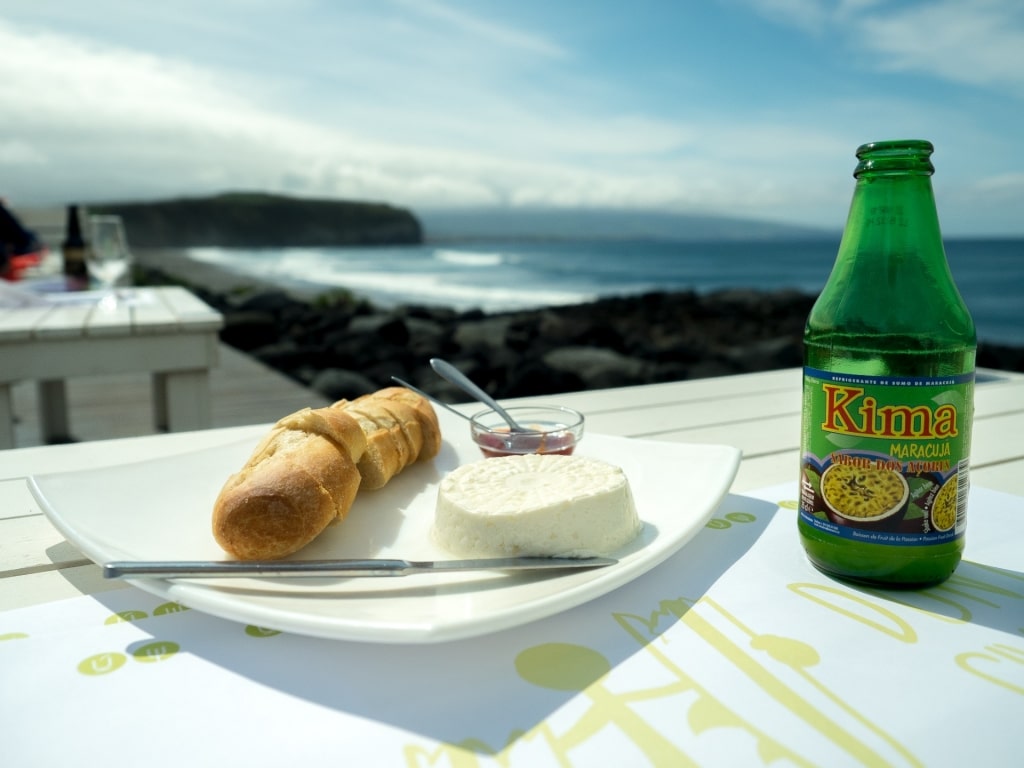
Kima Photo by ajay_suresh on Flickr, licensed under CC BY 2.0
The Azores’ signature sparkling soft drink, Kima, is flavored with the island’s delicious maracuja, or passion fruit.
While many small shops don’t seem to stock Kima, you’ll usually find the small bottles in supermarkets and cafés.
The drink is best served over ice in summer. There’s a little pulp, as real fruit is used rather than flavoring, and while it has less sugar than some other soft drinks, Kima is still fairly sweet with a tangy taste.
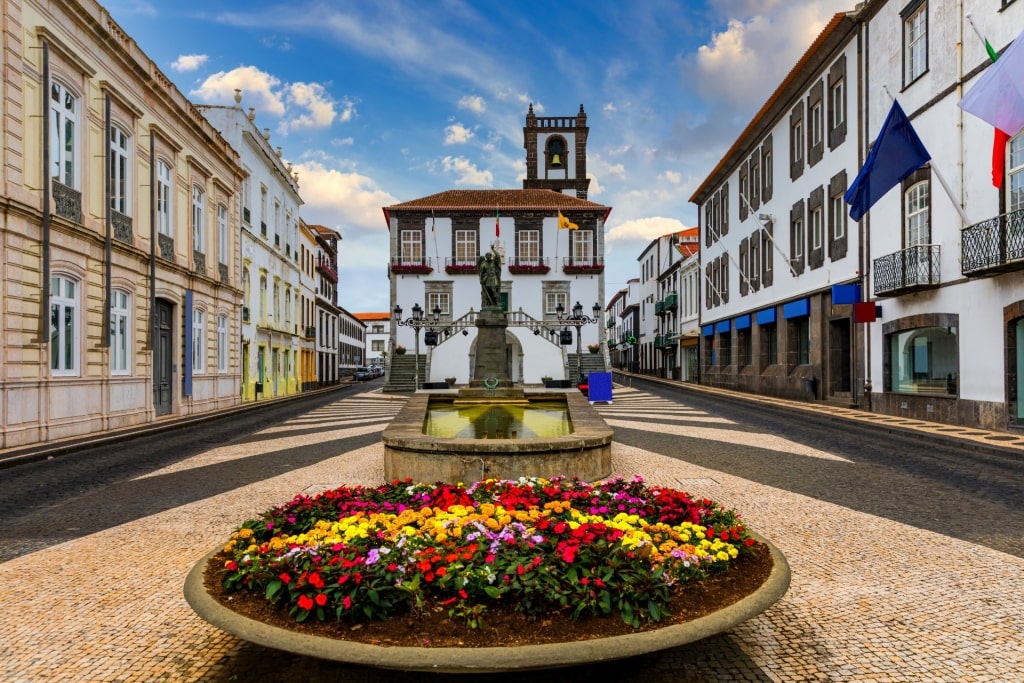
Ponta Delgada
Ready to taste the Atlantic-inspired flavors of the archipelago? Browse Celebrity’s Azores cruises to start planning your dream island vacation.
